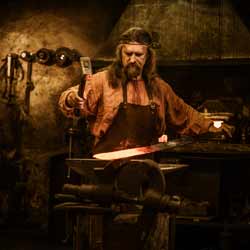Blacksmith Jobs
When was the last time you needed a blacksmith? How about the last time you even saw a blacksmith? Was it at a civil war reenactment or in a movie? Most likely you’ve never seen and will never need a blacksmith. It’s a dying art, but the job does still exist. Do you know what a blacksmith does?

Blacksmiths work with and repair metal. Primarily using iron and steel, blacksmiths use red-hot fire to heat metal into a malleable form where they can hammer, bend, cut, form, and create a variety of goods.
Back in the olden days, a blacksmith was necessary for everything from guns to horseshoes. Technology changed that. Now most of the work blacksmiths once did, is done by machine. But blacksmiths still do plenty of work.
Blacksmiths create tools like drills and chisels or custom metal work for gates, railings, furniture, weapons, tables, light fixtures, sculptures, plant hangers, hooks, and doorstops. Their work is a form of functional art. It’s heavy duty, resists wear and tear, looks stylish, and performs a task.
Tools, fire, and metal fascinate blacksmiths. In order to mold metal into intricate functional pieces, metal must be heated to extreme temperatures in a forge. At higher temperatures metal is more malleable. Weighted hammers, tongs, anvils, forges and safety equipment are all used daily in this dangerous art. The hammers are used to hit and bend the metal around an anvil, which has faces and horns used to flatten and round. Anvils are most recognizable as the big black metal things from Road Runner cartoons. Every tool a blacksmith uses is important and can be purchased from a blacksmith supplier – another unique job.
Although there are no formal requirements to learn the art of blacksmithing, many seek out apprenticeships with experienced blacksmiths or take courses.
Several university art programs, like at the University of Washington, offer blacksmithing. Another option is to take one of over thirty blacksmithing specific courses at John C. Campbell Folk Art School.
Blacksmithing is a skill that results in functional art. Experience is important to start producing quality work. It’s a good idea to find a niche. Specialize in door ornaments, kitchen utensils, or decorative railings or fences. Read blacksmith magazines and browse the Internet to see what’s going on in the blacksmithing world.
Besides selling functional art, blacksmiths can find work in other ways. They can specialize as a farrier making and fixing horseshoes. Blacksmith also perform at civil war reenactments, fairs, and museums. After lots of experience, a blacksmith can even become an instructor at a blacksmithing school.
Quality functional art is easy to market and sell, but be sure to set prices that cover equipment, costs, and time. Blacksmithing is a dangerous and expensive hobby and business. It’s also time consuming. Plan to work 35 to 45 hours per week for about $15 to $25 dollars per hour or about $25,000 per year.
Remember, the more you sell, the more you make.
Take a look around your world and see how many things a blacksmith may have created. Doorstops? Fences? Coat Racks? Kettles? Art pieces? You’ll be impressed by the high quality craftsmanship of a talented blacksmith.
This art has been around for over 3,000 years and it is here to stay. If you like playing with fire, bending metal, and being creative maybe you can help keep blacksmithing alive.
Quick Facts About Blacksmithing Work
Job Title: Blacksmith
Office: Extremely hot work area
Description: Work with tools and fire to shape steel and iron
Certifications/Education: No formal training. Art school or apprenticeship are highly recommended
Necessary Skills: Physically fit, creative, hand-eye coordination
Potential Employers: Self-employed
Pay: $25 per hour
Helpful Blacksmith Employment Links:
Search Blacksmith Jobs on JobMonkey
Artist Blacksmith Association of North America
Blacksmiths Journal
Blacksmith Depot
List of Blacksmith Schools
National Ornamental and Miscellaneous Metals Association


 Teach English in Asia
Teach English in Asia  Cruise Ship Jobs
Cruise Ship Jobs  Alaska Fishing Industry Jobs
Alaska Fishing Industry Jobs  Sharing Economy / Gig Economy
Sharing Economy / Gig Economy